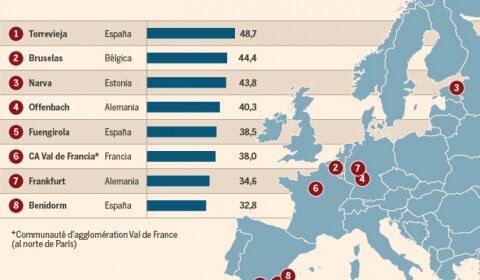
We all know that the cost of living is much higher in some parts of Spain than others. Principally, the larger cities come under this category. However, when you actually live in one of these areas, everything is more or less relative. Yes, rent is more expensive, eating out may set you back more and transport costs may be double what you pay elsewhere, but then again, people earn more money and so can afford the higher rates.
But how much more expensive is it really to live somewhere like Madrid or Barcelona? A recent study carried out by Kelisto.es has analysed how much consumers spend on the same products and services in various cities and province capitals around the country.
The study has looked at five different categories: housing, taxes, public transport, food shopping and leisure.
Generally, the cost of living in Barcelona is 30% higher than the national average, which makes it the most expensive capital in the country. Barcelona is followed by San Sebastián (28% above the average) and Madrid (23% above the average).
The most economical province capital in Spain is Cáceres, where it is 16% cheaper than the national average, followed by Lugo (-14%) and Palencia (-13%).
There are major differences between the various services and products looked at in the study. The greatest gap is found in the payment of the IBI property tax. Between the city where residents are charged the most for this tax, Lérida, and that where it is cheapest, Pamplona, there is a difference of 58%.
When it comes to the weekly shopping basket, there is less of a margin between prices. A weekly shop in the most expensive capital, San Sebastián, is only 16% more expensive than in the cheapest, Jaén.
And, regarding road tax that drivers must pay to have their car on the road each year, the most expensive cities are San Sebastián (86,30 euro), followed by Tarragona, Palma de Mallorca, Lleida, Santander, Oviedo, Ciudad Real, Valladolid, Huelva, Castellón de la Plana and Granada.
The areas where drivers are taxed the least are Melilla (17 euro) and Ceuta (34 euro).
When it comes to municipal taxes, those that live in Córdoba, Burgos and Gerona have to fork out the most at 52% - 67% higher than in other areas. At the other end of the scale are Las Palmas de Gran Canaria (68% less) and Badajoz (58% less). The highest amount paid is 315 euro, while the lowest amount is 79 euro.
Travelling around a city is often easier, faster and more economical than driving by car. Taking the Metro in Barcelona will cost you 2,15 euro for a single ticket (79% higher than the average). In San Sebastián, the same will cost you 1,65 euro, and in Madrid, 1,50 euro. On the other hand, in Lugo, a one-way ticket will only set you back 0,64 euro and in Palencia, just 0.65 euro.
If you have to take a taxi, take care in Tarragona, Madrid and San Sebastián, as these are the cities where taxi rates are highest. The cheapest tariffs are found in Ceuta, and Santa Cruz de Tenerife.
And finally, when it comes to going out in the evening or at weekends, going to the cinema costs the most in Barcelona and is cheapest in Granada, while restaurants in Zaragoza have the highest prices and those in Huesca, the lowest.
Source: www.abc.es
Categories:









